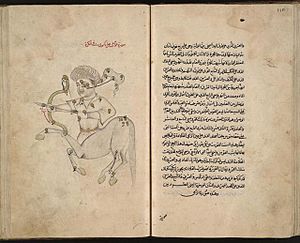Abd al-Rahman al-Sufi facts for kids
Quick facts for kids
ʿAbd al-Rahman al-Sufi
|
|
|---|---|
| Born | December 7, 903 Rey, Jibal, Abbasid Caliphate
|
| Died | May 25, 986 (aged 82) |
| Occupation | Astronomer |
| Era | Islamic Golden Age |
|
Notable work
|
Book of Fixed Stars |
ʿAbd al-Rahman al-Sufi (Persian: عبدالرحمن صوفی; born December 7, 903 – died May 25, 986) was an Iranian astronomer. He was also known by other names like Azophi in the West. Al-Sufi published his famous Book of Fixed Stars in 964. This book included detailed descriptions and pictures of stars. He lived at the Buyid court in Isfahan.
Biography
ʿAbd al-Rahman al-Sufi, whose full name was Abu al-Husayn ʿAbd al-Rahman ibn 'Umar, was one of the most famous Muslim astronomers. His name suggests he was a Sufi Muslim. He worked for Emir 'Adud al-Dawla in Isfahan, Persia.
Al-Sufi spent time translating and adding to Greek astronomy books. He especially focused on the Almagest by Ptolemy. Al-Sufi made some corrections to Ptolemy's list of stars. He also estimated the brightness and magnitude (how bright a star appears) of stars.
He played a big part in bringing Hellenistic (ancient Greek) astronomy to the Arabic world. This type of astronomy was mainly studied in Alexandria, Egypt. Al-Sufi was the first to try to connect Greek and Arabic star names and constellations. These names were often very different and sometimes overlapped in confusing ways.
Astronomy and the Book of Fixed Stars

Al-Sufi made his observations from Isfahan. He is famous for making the earliest recorded observation of the Andromeda Galaxy in 964. He described it as a "small cloud." This was the first galaxy (other than our own Milky Way) to be written about.
In 964, Al-Sufi published his important book, Kitab al-Kawatib al-Thabit al-Musawwar, also known as the Book of Fixed Stars. He dedicated this book to 'Adud al-Dawla, the ruler at that time. The book describes 48 constellations and the stars within them.
Inside the Book of Fixed Stars, Al-Sufi compared Greek and Arabic constellations and stars. He showed which ones were the same in both cultures. For each constellation, he included two pictures. One picture showed the stars as if you were looking at them from outside the celestial globe (a model of the sky). The other showed them as if you were looking up at the sky from Earth.
He divided the constellations into three groups:
- Twenty-one northern constellations.
- Twelve zodiac constellations.
- Fifteen southern constellations.
For each of these 48 constellations, Al-Sufi provided a star chart. These charts included the names and numbers of individual stars. They also showed their positions (longitudinal and latitudinal coordinates), their brightness (magnitude), and whether they were north or south of the ecliptic (the path the Sun appears to take across the sky).
Al-Sufi's charts were based on Ptolemy's earlier work. However, Ptolemy had published his Almagest 839 years before Al-Sufi. Because of how stars slowly shift over time (called procession), Al-Sufi added 12° 42' to the longitudes Ptolemy had given. This made his star positions more accurate for his time.
Al-Sufi also used a three-level scale to measure star brightness. This was more detailed than Ptolemy's two-level scale. This extra level helped make his measurements more precise.
Even though the Book of Fixed Stars is very important, it took over a thousand years for the first English translation to be published in 2010.
Al-Sufi also noticed that the ecliptic plane (the plane of Earth's orbit around the Sun) is tilted compared to the celestial equator. He also calculated the length of the tropical year (the time it takes for the Sun to return to the same position in the sky) very accurately.
Al-Sufi also wrote about the astrolabe, a tool used for astronomy and navigation. He found over 1000 different ways to use it! These uses included astronomy, astrology, navigation, surveying, telling time, and finding the direction for Salat prayer (Qibla).
Many other astronomers used Al-Sufi's work later on. One famous example is Ulugh Beg, who was both a prince and an astronomer.
Legacy
The lunar crater Azophi on the Moon is named after him. So is the minor planet 12621 Alsufi.
The Astronomy Society of Iran – Amateur Committee (ASIAC) holds an international Sufi Observing Competition. This competition is held in memory of Al-Sufi. The first competition was in 2006, and the second was in 2008. Over 100 people from Iran and Iraq took part in these events.
On December 7, 2016, Google Doodle celebrated his 1113th birthday with a special drawing.
Gallery
-
Constellation Taurus
-
Constellation Cancer
-
Constellation Lepus
-
Constellation Gemini
-
Constellation Andromeda
-
Constellation Ophiuchus
See also
 In Spanish: Abd Al-Rahman Al Sufi para niños
In Spanish: Abd Al-Rahman Al Sufi para niños
- Brocchi's Cluster
- Astronomy in the medieval Islamic world
- List of pre-modern Iranian scientists and scholars
- List of scientists in medieval Islamic world







